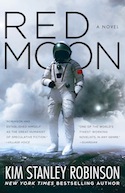Future Alternative Past: Talking Trash
Every month, Nisi Shawl presents us with news and updates from her perch overlooking the world of science-fiction, fantasy, and horror. You can also look through the archives of the column.
A couple of weeks ago, my mother died, suddenly and unexpectedly. Through a fog of grief, I’ve been handling clearing out her apartment; this includes sorting through the material remnants of her life and categorizing them as merchandise versus donations versus garbage. Which is why I’m now thinking about trash in speculative fiction.
It’s a truism that SFFH interrogates basic concepts such as the defining boundaries of consciousness. Also, though, it addresses more mundane issues. Like, what’s garbage? What’s salvage? How can you transform one into the other? And how do the answers to these sorts of questions affect the fictional worlds in which they’re asked?
Inside spaceships and artificial habitats, recycling holds pride of place. Such closed systems must reuse their components indefinitely, breaking them down and reconstituting them ad infinitum. Though I can’t recall which specific stories I first read dealing with this idea (see “fog of grief” above), it’s deeply enough engrained in me that I automatically incorporate it into my own work. “Maggies,” for instance, which first appeared in the second volume of the groundbreaking Dark Matter anthology series, takes place in an off planet underwater terraforming station; in a casual aside I describe a character tossing napkins “into the paper cycler.”
In Dune the fremen of Frank Herbert’s desert planet Arrakis wear “stillsuits,” specially engineered unitards which capture and recycle water normally released via feces, urine, sweat, and exhaled vapors.
William Tenn’s famous “Down among the Dead Men” pushes the conceit of recycling human resources nastily further, positing a future government which not only reclaims used fuels and minerals but reanimates dead soldiers and sends them back into military service.
Nearer to imminent realization is the premise of Ray Bradbury’s 1953 short story “The Garbage Collector,” in which an ordinary man rebels against prosaically horrible instructions for retrieving dead bodies in the event of a nuclear attack. Seattle author Nicola Griffith’s Nebula and Lambda award-winning novel Slow River also hews more closely to current possibilities in its sfnal take on the technology of pollution remediation.
Samuel R. Delany’s Empire Star delivers a bit of Darko Survin's “cognitive estrangement” by showing its characters’ bemusement at our culture’s revulsive reaction to shit — even unto a taboo against talking about it. As one tells another, “food once eaten and passed from the body could not be spoken of by its common name in polite company.” Fantasy sometimes does the opposite, replicating attitudes like these to create bridges between readers and its imaginary worlds. Robert Jackson Bennett’s Foundryside depicts super thief Sancia Grado predictably sneaking toward her target through sewers — but then not-so-predictably, though logically, alerting foes to her presence due to the powerful odor with which said sewers imbue her.
A few SFFH films come to mind, too, touching on this topic. The notorious trash compactor scene in Star Wars: A New Hope ignores the waste-not-want-not ethos mentioned earlier, with our heroes wading ankle deep through smelly chunks of grunge floating in a nameless liquid noxiousness from which the precious water has clearly not been extracted. The outpost dwellers in Kenyan filmmaker Wanuri Kahiu’s short Pumzi deal with their waste very simply, by ejecting it from their doors into the surrounding desert. They do go to great lengths to conserve water, though. And then there’s WALL-E, the 2008 animated movie about a robot trying to clean up an entire planet’s worth of trash. Which we must hope is a completely implausible extrapolation from the worst take on our contemporary garbage-or-not conundrum.
Recent books recently read

Richard K. Morgan’s new cybernoir novel Thin Air (Del Rey) is fat with all kinds of goodness. There’s the exploding-heads-and-voiding-guts sort, the expected excitement of balletic violence depicted with flair, even grace. But there’s also the novel’s wonderfully respectful treatment of its women characters.
With Thin Air’s relentlessly fast action unfolding on a halfway settled Mars only gradually easing back from its frontier attitudes, this is saying something. But though narrator Hakan Veil is a genetically enhanced male, a corporate enforcer permanently stranded far from the green hills of Earth; and though he does plenty of digging to find out how and why mysterious killers are aiming at him, it’s the book’s women who make the crucial difference in this battle between good and evil. The whore next door, the beat-weary detective, the cynical heir of a revolution — all act according to their particular priorities and so further a plot in which more than one gender holds up the paprika-colored Martian sky.

In Red Moon (Orbit), veteran SF author Kim Stanley Robinson once again turns a pragmatic eye on the possibility of colonizing nearby space. He writes with straight-on verisimilitude of China winning the race to lunar domination: their pressurized crawlers scrambling over blazingly white and depthlessly black landscapes, their high-speed trains hurtling along beneath an Earth taking hours to rise apparent inches. China is well established at the Moon’s South Pole, with the U.S. less settled in at the North Pole and struggling to catch up. The enclave of a mysterious billionaire and a utopic socialist community have niches on this satellite as well. But as with Morgan, it’s Robinson’s facility with outsider viewpoints that commands amazed focus. An elderly entertainer, a non-neurotypical quantum engineer, a pregnant labor organizer — Buzz Aldrins they ain’t. Fascinating they are, though, as they wrestle with internal party politics and the almost-offhand destruction of capitalism.
Couple of upcoming cons
Once again the World Fantasy Convention sings its siren song. Guests of Honor from Australia and Paris vouch for WFC’s internationality, and this year’s list of nominees for the prestigious World Fantasy Award presented there is rife with authors outside the dominant demographic paradigm — women, non-gender binary folks, and People of Color. Even at unofficial events such as its “barcon” (a nickname for the daily gathering of geeks in the convention hotel’s bar),World Fantasy’s level of discourse is high. Listen — can you hear its heady call? Answer at will.
Or maybe you’re more drawn to the well-seasoned attractions of Philcon, SFFH’s longest-running convention. The cumulative power of 81 years-worth of panels, writing workshops, masquerades, films, art shows, games, contests, and readings is not to be lightly dismissed. Home to three previous World Science Fiction Conventions (Philcon I, Philcon II, and Millenium Philcon), this is one con that knows its place — not just its geographical location (roughly Philadelphia, if you count New Jersey), but its importance in the genre’s history. This photo of all but one of Philcon’s first attendees says volumes about the future’s past. Attend and you could have something to say about the future’s future.